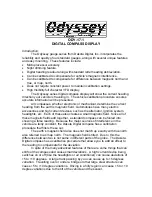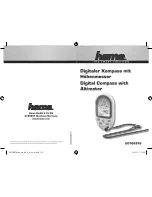
ODY-17-1
DIGITAL COMPASS DISPLAY
Introduction:
The Odyssey gauge series from Dakota Digital, Inc. incorporates the
reliability and quality of our standard gauges, along with several unique features
and easy mounting. These features include:
•
Microprocessor
accuracy.
•
Night dimming feature.
•
Digital heading readout along with standard letter heading abbreviation.
•
Can be calibrated to compensate for vehicle’s magnetic interference.
•
Can be calibrated to compensate for difference between magnetic north and
true, or map, north.
•
Does not require constant power to maintain calibration settings.
•
High Visibility full character VFD display.
The Odyssey series digital compass display will show the current heading
direction your vehicle is traveling in. The vehicle calibration procedure ensures
accurate information will be presented.
All compasses, whether electronic or mechanical, determine the current
heading from the earth’s magnetic field. Automobiles have many electric
accessories and high current devices, such as the alternator, ignition system,
headlights, etc. Each of these also creates a small magnetic field. Since all of
these magnetic fields add together, a standard compass can be fooled into
showing a false reading. Because the major sources of interference in the
vehicle are fairly constant, the Dakota Digital compass has a calibration
procedure that filters these out.
The earth’s magnetic field also does not match up exactly with true north,
also referred to as map north. The magnetic field is tilted. Due to this the
difference between two is not same in different parts of the globe. The Dakota
Digital compass has a calibration procedure that allows you to add an offset to
the reading to compensate for the deviation.
In spite of the many advanced features of there are some things that can
still fool the compass and cause small deviations. A high current device being
switches on or off (like the headlights or air conditioner) can cause deviations of
±
5 to
±
10 degrees. A large truck passing by you can cause up to
±
5 degrees
variation. Travelling over or under a bridge or other large steel structure can
cause
±
5 to
±
10 degree variations. Driving in a hilly region can cause
±
5 to
±
10
degree variations due to the tilt of the vehicle and the sensor.














